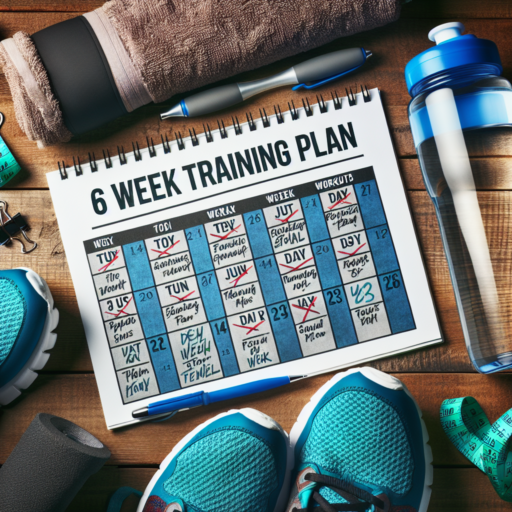Introduction to the 800m Training Plan
Embarking on an 800m training plan is an exciting journey for athletes of all levels. This middle-distance event, straddling the boundary between sprinting and long-distance running, requires a unique blend of speed, endurance, and strategic racing tactics. The purpose of this introduction is to lay the foundation for a training plan that caters to the specific demands of the 800m race, ensuring athletes can enhance their performance and achieve their personal best.
To excel in the 800m, it’s essential to understand the dual nature of the race. It’s not just about having the explosive power of a sprinter or the stamina of a long-distance runner; it’s about possessing a harmonious balance of both. Therefore, a well-structured 800m training plan focuses on developing speed endurance, efficient pacing, and tactical race strategies. These elements are crucial for successfully navigating the complexities of the 800m and crossing the finish line with a time you’re proud of.
Initiating your training with a clear understanding of the physiological demands of the 800m is key. The race predominantly utilizes the anaerobic lactic acid system, with an aerobic contribution that cannot be ignored. This unique demand means that athletes must tailor their training to enhance their lactate threshold and improve their aerobic capacity. Incorporating a variety of workouts, including interval training, tempo runs, and strength and conditioning exercises, will prepare your body to handle the intense demands of the 800m.
Understanding the Basics of 800m Running
The 800m race, a middle-distance track event, requires a blend of speed, strategy, and endurance. Grasping its fundamentals is crucial for athletes aspiring to excel in this dynamic race. This introduction to the basics of 800m running will provide emerging athletes and enthusiasts with the foundational knowledge needed to understand and appreciate the sport more profoundly.
Key Components of 800m Running
An essential aspect of 800m running involves mastering pace. Unlike shorter sprints, where athletes run at maximum speed, 800m runners must find a balance between a fast start and conserving energy for a strong finish. Another critical factor is endurance; athletes need a solid base of mileage to perform well in the 800m. Additionally, strategy plays a significant role, with runners needing to make real-time decisions about positioning and pacing relative to their competitors.
Physical and Mental Preparation
- Training: A mix of speed work, endurance runs, and interval training is essential for building the physical capabilities required for 800m success.
- Mental Fortitude: The mental aspect of 800m running cannot be understated. Athletes must develop resilience, focus, and the ability to maintain composure under pressure.
Understanding the basics of 800m running is the first step towards achieving excellence in this challenging and rewarding event. Through diligent training, strategic planning, and mental preparation, athletes can unlock their potential and excel in the 800m run.
Key Components of an Effective 800m Training Plan
An 800m race is a demanding middle-distance event that requires an optimal balance of speed, strength, and strategy. Creating an effective training plan for this event involves focusing on several critical components to enhance performance. Understanding these elements can help athletes develop the stamina and speed necessary to excel in the 800m.
Developing Aerobic Capacity
The cornerstone of any successful 800m training plan is building a strong aerobic base. This involves long-distance running at a moderate pace to improve cardiovascular endurance. Enhancing aerobic capacity allows athletes to maintain a high intensity for the duration of the race, a critical factor in the 800m where energy management is key. Incorporating distance runs, recovery runs, and tempo runs into the weekly training schedule can substantially increase an athlete’s aerobic power.
Speed and Anaerobic Training
Equally important is the development of speed and anaerobic conditioning. This component focuses on improving the athlete’s ability to sustain high speeds over the course of the 800m. It includes high-intensity interval training (HIIT), sprint intervals, and speed endurance workouts. These sessions are designed to enhance the athlete’s lactate threshold, enabling them sooner to recover from high-intensity efforts and maintain faster speeds for longer durations.
Strength and Flexibility
Strength training and flexibility exercises are vital to preventing injuries and improving overall performance in the 800m. Incorporating weight training and plyometric exercises into the regimen can significantly improve an athlete’s power and efficiency. Meanwhile, flexibility and stretching exercises ensure that muscles remain supple and less prone to injury, allowing for greater range of motion and more powerful strides. Regular attention to these areas complements the cardiovascular and speed work by building a well-rounded, resilient athlete capable of executing a strong race strategy.
Weekly Breakdown of the 800m Training Schedule
The 800m race is a demanding middle-distance event that requires a blend of speed, endurance, and strategy. A well-structured training schedule is crucial for athletes aiming to improve their performance in this challenging race. This guide provides a weekly breakdown to help runners optimize their training and achieve their personal best in the 800m event.
Monday: Speed Endurance and Recovery
Starting the week, focus is on building speed endurance. A typical Monday includes intervals at a slightly longer distance than 800m to enhance the body’s ability to maintain high speed over the duration of the race. This is followed by sufficient recovery time, emphasizing low-intensity activities or complete rest to allow the body to recover and adapt.
Wednesday: Tempo Runs and Strength Training
Midweek training involves tempo runs designed to improve lactate threshold, which is crucial for 800m runners. These runs are performed at a steady, controlled pace, slightly slower than race pace, to enhance metabolic efficiency. Post-tempo run, athletes should engage in strength training focusing on core stability and leg strength, which are vital for maintaining form and preventing injuries in shorter distance races.
Friday: Speed Work and Technique
The end of the week targets speed work to improve running economy and racing speed. Sessions typically include shorter intervals at or faster than race pace, with an emphasis on maintaining proper running technique. This not only helps improve performance but also minimizes the risk of injury by ensuring that runners use their energy efficiently throughout the race.
Strength and Conditioning Exercises for 800m Runners
Strength and conditioning exercises are pivotal in the preparation of 800m runners. These athletes require a unique blend of speed, endurance, and muscle stamina to excel in their event. By integrating specific exercises into their training regimen, runners can drastically improve their performance. This segment discusses some of the fundamental exercises tailored to enhance the capabilities of an 800m runner.
Core Stability and Strength Exercises
Core stability is crucial for maintaining proper form and efficiency during the 800m race. Exercises such as planks, side planks, and Russian twists not only strengthen the core muscles but also improve the runner’s balance and coordination. Incorporating these exercises helps in minimizing the energy loss during transitions from the aerobic to the anaerobic phase of the race.
Lower Body Strength and Power Development
The explosive power of the legs is essential for a strong start and finish. Squats, lunges, and calf raises build the necessary muscle endurance and strength. Additionally, incorporating plyometric exercises like box jumps and bounds can significantly increase power output. These exercises are vital in enhancing the runner’s kick, especially in the final stretch of the race.
Overall, the integration of both core and lower body workouts ensures a balanced training approach. It not only optimizes performance but also minimizes the risk of injury. Tailoring these exercises to the individual needs of the 800m runner can make a substantial difference in achieving their racing goals.
Nutrition and Recovery Strategies for 800m Athletes
Optimizing nutrition and recovery strategies is crucial for 800m athletes striving to achieve peak performance. This middle-distance event demands a balanced blend of speed, endurance, and strategy, all of which can be significantly influenced by dietary choices and recovery methods. Understanding the best practices in these areas can make a substantial difference in an athlete’s training and competition results.
Key Nutritional Focus Areas for 800m Athletes
For 800m athletes, paying attention to specific nutritional needs is essential. A diet rich in complex carbohydrates provides the necessary energy for rigorous training sessions and competitive races. Additionally, incorporating a sufficient amount of proteins is vital for muscle repair and growth. Equally important is the hydration strategy; maintaining optimal fluid balance before, during, and after performances can considerably impact an athlete’s capability to train effectively and recover swiftly.
Effective Recovery Methods
Recovery plays a pivotal role in an 800m athlete’s regimen. Techniques such as active recovery, including light jogging or cycling, help in flushing out lactic acid from the muscles, reducing soreness, and enhancing overall recovery speed. Furthermore, incorporating stretching exercises post-training sessions or races can improve flexibility and decrease the risk of injuries. Lastly, ensuring adequate sleep should never be underestimated, as it is during this restful period that the body undertakes the bulk of its healing and repair processes.
No se han encontrado productos.
Technique Improvement Tips for 800m Success
Improving your technique in the 800m event is crucial for achieving better times and more consistent performance. The 800 meters, a middle-distance race that mixes the endurance of long-distance events with the speed of shorter sprints, demands a unique balance of speed, strategy, and stamina. Mastering this balance through refined techniques can make the difference between a personal best and falling short of your goals.
Optimizing Your Start for Maximum Efficiency
One key area for technique improvement is your start. The initial phase of the 800m race sets the tone for the entire race. Practicing a powerful and efficient start can conserve valuable energy that will be needed in the latter stages of the race. Focus on explosive power off the block, minimizing ground contact time while maximizing forward momentum. This small but critical phase of the race often determines your position as the race progresses into the curve and onto the final straightaway.
Mastering the Art of Pacing
Arguably, pacing is the most crucial component of 800m racing technique. Striking the right balance between conserving energy and maintaining a competitive speed is a skill that requires practice and strategic planning. An effective strategy is to break the race into segments, each with its own pace target. Athletes should practice varying their speed in training to find an optimal pace that feels sustainable yet fast, allowing for a strong finish without the risk of burning out too early. Understanding your own racing capabilities and developing a tailored pacing strategy is indispensable for 800m success.
By focusing on these technique improvement tips, athletes can work towards achieving greater success in the 800m. Practicing efficient starts and mastering the pacing strategy are foundational elements that contribute to achieving personal bests and competing at higher levels. Remember, consistency in application and dedication to improvement are key to seeing gradual and sustained improvement in your 800m performance.
How to Adapt the 800m Training Plan for Beginners
Adapting an 800m training plan for beginners requires a balance between building endurance and working on speed. It’s essential to introduce new athletes to the concept of interval training gradually. Interval training helps simulate the race’s pace and intensity without overwhelming the runner. Beginners should start with shorter distances, gradually increasing as they become more comfortable and their fitness levels improve.
Understanding Your Body’s Limits is crucial when adapting any training plan. For beginners, it’s important to start with a comprehensive evaluation that includes assessing current fitness levels, flexibility, and any potential muscle imbalances. This evaluation can help in tailoring the 800m training plan to fit individual needs, ensuring that the intensity and volume of training do not lead to injuries. Listening to your body and allowing adequate rest days is key to preventing overtraining and promote recovery.
Incorporating Strength Training and Flexibility Exercises into the 800m training plan for beginners can significantly improve performance and reduce injury risk. Exercises focusing on core strength, leg power, and overall stability are particularly beneficial. Additionally, integrating flexibility workouts, like dynamic stretching before runs and static stretching after, can enhance range of motion and muscle responsiveness, which are vital for excelling in track events like the 800 meters.
Common Mistakes to Avoid in 800m Training
Training for an 800m race can be as complex as it is rewarding. Achieving the perfect balance between speed and endurance requires a strategic approach, yet, it’s common to see athletes falling into certain traps during their training. Understanding these pitfalls can significantly enhance your training outcomes.
Overlooking Proper Warm-up and Cool-down Routines
One of the most critical mistakes to avoid is skipping proper warm-up and cool-down sessions. A comprehensive warm-up not only prepares your body for the intensive workout ahead but also reduces the risk of injury. Similarly, a thorough cool-down helps in faster recovery, ensuring your muscles are well-rested and less prone to soreness. Ignoring these routines can hinder your performance and progress in the long run.
Ignoring the Importance of Pace Variation
Another key aspect where many 800m athletes falter is in the lack of pace variation in their training. Integrating different pace sets, including sprints and long-distance jogs into your regimen, is paramount. This not only aids in boosting your endurance but also improves your speed. Athletes often underestimate the importance of such variations, leading to a plateau in performance levels. Incorporating diverse pace workouts ensures that your body can handle the rigorous demands of the 800m effectively.
Focusing Solely on Track Work
Last but not least, focusing exclusively on track work without cross-training can limit your progress. Strength training, plyometrics, and even yoga can enhance your overall athleticism, which in turn, benefits your 800m performance. These activities build muscle, improve flexibility, and increase core strength, all of which are crucial for a middle-distance runner. Neglecting these aspects of training can prevent you from reaching your full potential.
Measuring Progress and Adjusting Your 800m Training Plan
When it comes to enhancing your performance in the 800m race, tracking your progress and making necessary adjustments to your training regimen are fundamental. By keeping a close eye on various performance indicators, you can make informed decisions on how to tweak your 800m training plan efficiently. This ensures that your efforts align closely with your ultimate racing goals.
Key Performance Indicators (KPIs) to Measure: To accurately assess your progress, focus on a comprehensive set of KPIs, including time trials, aerobic capacity, and recovery rates. Logging these metrics regularly provides a clear picture of where you stand and highlights areas requiring attention or adjustment in your training strategy.
Understandably, the process of refining your 800m training plan based on your progress involves a blend of science and personal insight. By continually assessing your performance data against your goals, you position yourself to make strategic alterations that cater specifically to your needs and competitive aims. This dynamic approach to training ensures you remain on the most effective path to achieving your 800m ambitions.




